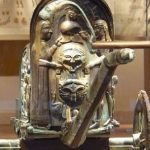 History
History  History
History  Technology
Technology Top 10 Everyday Tech Buzzwords That Hide a Darker Past
 Humans
Humans 10 Everyday Human Behaviors That Are Actually Survival Instincts
 Animals
Animals 10 Animals That Humiliated and Harmed Historical Leaders
 History
History 10 Most Influential Protests in Modern History
 Creepy
Creepy 10 More Representations of Death from Myth, Legend, and Folktale
 Technology
Technology 10 Scientific Breakthroughs of 2025 That’ll Change Everything
 Our World
Our World 10 Ways Icelandic Culture Makes Other Countries Look Boring
 Misconceptions
Misconceptions 10 Common Misconceptions About the Victorian Era
 Mysteries
Mysteries 10 Strange Unexplained Mysteries of 2025
 History
History 10 Things You Didn’t Know About the American National Anthem
 Technology
Technology Top 10 Everyday Tech Buzzwords That Hide a Darker Past
 Humans
Humans 10 Everyday Human Behaviors That Are Actually Survival Instincts
Who's Behind Listverse?

Jamie Frater
Head Editor
Jamie founded Listverse due to an insatiable desire to share fascinating, obscure, and bizarre facts. He has been a guest speaker on numerous national radio and television stations and is a five time published author.
More About Us Animals
Animals 10 Animals That Humiliated and Harmed Historical Leaders
 History
History 10 Most Influential Protests in Modern History
 Creepy
Creepy 10 More Representations of Death from Myth, Legend, and Folktale
 Technology
Technology 10 Scientific Breakthroughs of 2025 That’ll Change Everything
 Our World
Our World 10 Ways Icelandic Culture Makes Other Countries Look Boring
 Misconceptions
Misconceptions 10 Common Misconceptions About the Victorian Era
 Mysteries
Mysteries 10 Strange Unexplained Mysteries of 2025
10 Strange Artworks That Can Be Found in Nature
Art is most commonly found within—and on—the walls of galleries and museums, but some artworks are placed in nature. A natural setting—be it deep in a forest or in the middle of a desert—can make a piece of art seem extra strange. Just think of the mirrored monoliths that started mysteriously popping up around the world back in 2020. In a museum, these monoliths wouldn’t have been that eerie, but by standing in remote places, they took on an odd aura.
Here are 10 of the strangest artworks that can be found in nature around the world—some of which are weird but beautiful, and others that are just downright creepy.
Related: 10 Amazing Unfinished Sculptures
10 Elmer Long’s Bottle Tree Ranch
Elmer Long’s Bottle Tree Ranch proves that one man’s trash is another man’s treasure. Lying along a road stretching through the desert near Helendale, California, the Bottle Tree Ranch is an outdoor art exhibition consisting of metal pipes that have been covered with glass bottles. Elmer Long started the project in 2000 after inheriting his dad’s bottle-collecting habit, along with many of the bottles now on display.
Long created more than 400 of these steel and glass trees. When it came to arranging the bottles on the short rods, he was very methodical. “I divide them into colors, and I alternate on the pipes. Brown would be opposite green, and clear would be opposite blue, all in a clock position at 3, 6, 9, and 12,” he told Route Magazine.
Long passed away in 2019, but his bizarre Bottle Tree Ranch is still open to the public.[1]
9 The Painted Tanks on Flamenco Beach
Flamenco Beach on the Puerto Rican island of Culebra is a picture-perfect paradise—aside from the two M4 Sherman tanks that are sitting on the white sand. The story of the tanks goes back to 1901 when U.S. President Theodore Roosevelt gave all of Culebra’s public land to the U.S. Navy. In 1936, the Navy started using the land for bombing practice, leaving the island strewn with craters and debris from the impacts.
The residents of Culebra reached their breaking point in 1970—when the Navy tried to evict everyone—and started holding non-violent protests, including marches and human blockades. Their peaceful but tenacious efforts paid off after a few months, and the Navy agreed to leave the island by 1975.
However, they left a few tokens behind, including the two large tanks that now sit rusting on Flamenco Beach. The residents don’t seem to mind, though, and they’ve become works of art, regularly being covered in layers of colorful graffiti.[2]
8 The Giant Moss-Covered Sculptures in Jardim do Nêgo (Nêgo’s Garden)
In the mountains of Nova Friburgo, Brazil, lies a strange sculpture garden filled with huge clay figures. Along with animals—such as a frog, elephant, and snake—there are also rather unsettling human statues, such as a giant baby and a woman giving birth. Although obviously man-made, the moss growing on the massive sculptures gives them a weirdly natural feel.
The clay sculptures were created by artist Geraldo Simplício—usually just known as Nêgo—who moved to the mountainous area decades ago and has been crafting the large clay figures ever since. He’s often hanging around the garden, so visitors can chat with him while marveling at his larger-than-life creations.[3]
7 The Melting Rock Formation
For the past few years, Desert X—an open-air art exhibition—has been set up in the desert around the Saudi Arabian city of AlUla. One of the sculptures on display in 2024 was designed by artist Aseel AlYaqoub and essentially looked like a rock formation melting. Titled Weird Life: An Ode to Desert Varnish, the piece was inspired by the geological process called desert varnish, which is when the top layer of rock oxidizes, creating colorful patterns of red, orange, yellow, and black.
“The work encapsulates an ancient fleeting instance unseen by human observation—a cascade of desert varnish descending upon a mountain or rock, forever set in limbo,” reads the artwork’s official page. It took 440 pounds (200 kilograms) of tinted epoxy resin to create the creepy piece. Although the artwork was only on display for a limited time, its drippy texture certainly looked strange against the solid rock formations in the background.[4]
6 Otherworldly Conical Mounds in the Desert
Crop circles usually appear in, well, fields of crops, but a similar alien-looking formation can be found in the eastern Sahara Desert, near the north end of the Red Sea in Egypt. Comprised of two interlocking spirals—one of conical protrusions and the other of mirrored conical depressions—the formation has been there since March 1997.
Called “Desert Breath,” the artwork was created by artist Danae Stratou with the help of industrial designer Alexandra Stratou and architect Stella Constantinides. It stretches out over 1 million square feet (100,000 square meters). The tallest cones, at the outside of the spiral, are around twice the height of an average human, and they gradually shrink in size toward the center of the spiral, which is a circular pool of water. The cones have been left to slowly disintegrate, and although they aren’t as sharp anymore, they can still be seen today.
“In our mind’s eye, the desert was a place where one experiences infinity,” explains Stratou. People can either walk their way through the infinity-inspired spiral or take in an aerial view of the piece from the vantage point of the nearby mountain.[5]
5 The Eyes on a Mountainside
The walled medieval town of Cuenca in Spain is so well-preserved that it’s been awarded UNESCO World Heritage status. But while the old buildings of the fortress town are the star of the show, a strange piece of artwork literally overlooks the whole thing: Two huge blue eyes peer down at the town from a nearby mountainside.
Known as “Los Ojos de la Mora” (“The Eyes of the Moor”), the looming eyes look rather sinister, but there’s a tragically romantic tale behind them. The story goes that hundreds of years earlier, a Muslim woman and a Christian soldier fell in love. The woman’s father forbade their romance and planned to have her marry a fellow Moor. She rejected the man and planned to run away with her Christian lover, but the rejected suitor had her lover killed. The woman then died of a broken heart. The eyes on the mountain represent her eyes, and they supposedly mark the spot where the couple planned to meet before running away together.[6]
4 Creepy Faces Carved into Trees
Pareidolia is the name for humanity’s tendency to see faces or patterns where there actually are none. One example of this is seeing faces in the bark of trees, but anyone walking through Steckeschlääfer Gorge in Bingen Forest, Germany, will come across actual faces carved into the tree trunks and roots. The faces depict mythical creatures, such as goblins and trolls, and while some of them look fairly friendly, many of them have a bit of a sinister sneer.
The faces date back to 1971 and were carved by Franz Kellermeier. There are 66 faces that can be spotted on the short walk, which is less than a mile long. Anyone wanting a longer walk can make their way over to nearby Reichenstein Castle.[7]
3 A Surreal Cyclops Head in the Woods
In the woods surrounding the French commune Milly-la-Forêt stands a gigantic Cyclops head sculpture. The head of the bodiless being stretches 74 feet (22.5 meters) into the air and is made of 350 tons of steel. The Cyclops’s face is covered with mirrors, but the back of the head is mostly gears. Visitors can go inside the head via a staircase.
The one-eyed head was created by Swiss artist Jean Tinguely, his wife Nikki de St Phalle, and their friends. Work started in 1969, with the team using salvaged materials for the creation. However, it took many years for the piece—named “Le Cyclop”—to be completed, and it didn’t open to the public until 1994. The French state now looks after the massive sculpture to make sure the elements don’t destroy it. Access is free, but visitors can pay for a guided tour.[8]
2 Bomarzo’s Monster Garden
During the 16th century, Francesco Orsini, the Lord of Bomarzo, hired architect Pirro Ligorio to create a bizarre sculpture garden. Called Bosco Sacro di Bomarzo (The Scared Grove of Bomarzo)—but usually known as Parco dei Mostri (Park of the Monsters)—the space is home to an array of massive stone sculptures, some of which are rather unsettling.
Although there are non-scary statues, such as those of an elephant and a massive turtle, there are also a number of terrifying creations. The star of the horror show is the wide open mouth of Orcus, the god of the underworld, but visitors to the garden can also see mythical creatures and even a huge man ripping another man in half.
The sculpture park was actually left to ruin for hundreds of years after Bomarzo’s death. However, interest in the garden picked up after Salvador Dalí visited the site and created a short film about it in 1948. His 1964 painting The Temptation of Saint Anthony was also inspired by the monsters.
Why exactly Bomarzo wanted a garden filled with creepy stone figures remains a mystery. One theory is that it was intended as a garden of grief after his wife, Giulia Farnese, died. Another is that he wanted to create the opposite of Cristoforo Madruzzo’s garden, called Soriano di Cimino, which represented goodness.[9]
1 Doll’s Head Trail
Constitution Lakes Park in Atlanta, Georgia, is home to a 2.5-mile ((4-kilometer) walk called Doll’s Head Trail. As would be expected from that name, this trail through the woods is lined with artistically displayed doll’s heads and other discarded toys. The trail started taking shape back in 2011, thanks to Joel Slaton. “During my hikes at Constitution Lakes, I began finding doll, bicycle, automobile, and appliance parts. These became the original displays,” Slaton told CNN.
“The trail is now public art, built by the public,” Slaton said. “The displays have changed a lot over time, mostly due to cherry-picking and vandalism.” Although you never know what you’re going to see when you go down the trail, many of the displays have been immortalized online. One such creepy creation is an old doll combined with a fan blade that has puns—such as “a fan of art” and “spun out”—written on it.[10]








